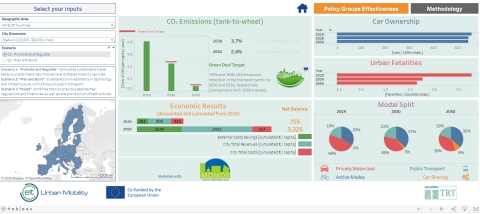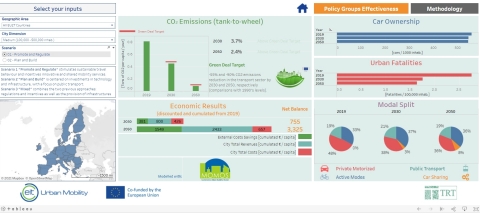BARCELONA, Spain--(BUSINESS WIRE)--Cities investing urgently in the shift to sustainable urban mobility in line with the Green Deal objectives could generate net benefits of up to €128 per citizen each year, finds a new report by EIT Urban Mobility, an initiative of the European Institute of Innovation and Technology (EIT), a body of the European Union. The report estimates that European cities need extra investments of 86bn in sustainable urban mobility compared to business-as-usual, leading to net benefits of up to €177bn by 2030.
Depending on the scale and type of mobility policies implemented by 2030, European cities [1] can create net benefits of up to €177bn. Of these net benefits, cities have the potential to generate €79bn in saved health costs linked to externalities avoided such as pollution and traffic accident fatalities [2]. On average, each euro invested in the transition can generate up to €3,06 by 2030 (i.e. up to €2,14 in revenues, and €0,92 in externalities savings). As world leaders stressed during COP 26 the urgency to commit to more ambitious climate policy, the report shows that investments in sustainable urban mobility options will pay off.
Following the simulation of three potential pathways to mobility sustainability, the study points out that reaching the Green Deal target [3] by 2030 would be extremely challenging and only possible through very urgent and drastic changes in the way people move in the short term (private motorized modal split needs to halve in the next 10 years). However, by 2050, when the penetration of alternative-fuelled vehicles will make up almost all the private vehicles, the implementation of more gradual and less extreme sustainable policy measures will also allow reaching the targeted CO2 emissions reduction.
Results show that by 2030 pricing schemes (Congestion and pollution charging, parking pricing, public transport integrated ticketing and tariff schemes) is the set of measures with the highest net benefits in small (50 000 – 100 000 inhabitants) and medium (100 000 – 500 000 inhabitants) cities, while Innovative Services (Demand Responsive Transport, autonomous vehicles, Intelligent Transport Systems) is the better choice for large (> 500 000 inhabitants) cities’ transition pathways.
By 2050, Innovative Services followed by Shared Mobility and Demand Management policies (Mobility as a Service, vehicle sharing, logistics delivery plans, teleworking) become the most profitable group of measures in contributing towards the Green Deal objectives in medium and large cities. Pricing Schemes remains the best option in small cities.
At EU-27 level, Shared Mobility and Demand Management policies have the highest impact on CO2 emission reduction for all city sizes, with different implications for costs and revenues based on the city size.
Transport Infrastructure measures (bus – small cities, tram – medium and large cities, metro – large cities, walking and cycling networks and facilities, urban delivery centres) are the ones with the largest differences in costs and revenues according to city sizes, from a net negative balance for large cities, to a positive net balance for small and medium cities.
Study results can be explored interactively on: https://public.tableau.com/views/CostsandBenefitsoftheUrbanMobilityTransitioninEurope/HOME?:language=en-US&:display_count=n&:origin=viz_share_link
More funding for cities on sustainable urban mobility policies would not only put them on track to meet transport CO2 reduction objectives, but also directly improve quality of life in urban areas: until 2030, their implementation in EU-27 cities has the potential to reduce mobility-related urban fatalities from 2.6 to 1.1 per 100 000 per inhabitants, lower car ownership rate from 526 to 363 cars per 1000 inhabitants and reduce the modal share of private motorised transport from 44% to 20%.
Dr Maria Tsavachidis, CEO of EIT Urban Mobility, said: “The climate emergency we face requires all of us to take immediate action, across sectors and geographies. Transport in cities is a major contributor to greenhouse gas emissions and must fundamentally transform to achieve climate neutral cities. Air and noise pollution levels, congestion, and road fatalities are daily reminders that we need now more than ever serious investments in sustainable urban mobility. Numbers clearly show these transformations are future-proof and can generate large benefits for citizens´ wellbeing and the economy, while reducing mobility-related greenhouse gas emissions.”
The study quantifies the costs and benefits of the urban mobility transition based on the implementation of three potential pathways to sustainability built on different sets of policy measures in addition to vehicle fleet decarbonization. These results are applied to different “City Prototypes” which take into account differences in cities based on their size and geographic location. Also, the study provides recommendations on the most effective groups of policies to be deployed, considering the associated costs and impact on greenhouse gas emissions reductions. The full results of the study can be explored interactively on the study’s interactive tool [4].
The report will be featured in a dedicated session of the Tomorrow.Mobility World Congress, taking place in Barcelona from 16 November to 18 November.
Transport experts TRT Trasporti e territorio [5] have carried out the analysis, using a modelling (performed with MOMOS [6]) which is based on objectives set in the Green Deal and the “Fit for 55” policy packages [7]. The scope of the analysis focuses on EU-27 cities of more than 50 000 inhabitants.
END
[1] 779 European cities of more than 50 000 inhabitants in the EU-27
[2] Benefits are calculated as revenues generated from the measures, saved costs from externalities, minus the implementation costs of the measures. So-called externalities, which relate to the costs saved coming from avoided injuries and diseases caused by air and noise pollution, as well as non-emitted greenhouse gases.
[3] -55% and -90% greenhouse gas reduction in the transport sector by 2030 and 2050, compared to 1990’s levels
[4] Interactive tool: https://public.tableau.com/views/CostsandBenefitsoftheUrbanMobilityTransitioninEurope/HOME?:language=en-US&:display_count=n&:origin=viz_share_link
[5] Trasporti e territorio: http://www.trt.it/
[6] MOMOS: http://www.trt.it/en/tools/momos/
[7] The scenarios were simulated considering a penetration of innovative vehicle technologies inspired to the EU "Fit for 55" Strategy (it is assumed a share of about 85% of electric vehicles in total European fleet by 2050). That said, the study considered only the costs affecting local authorities (such as costs for the green fuel recharging urban infrastructure to support fleet evolution). Other relevant costs associated (government incentives, costs for the automotive sector, etc.) belonging to external entities were not considered within the study.
BACKGROUND
About EIT Urban Mobility
EIT Urban Mobility, an initiative of the European Institute of Innovation and Technology (EIT), a body of the European Union, aims to accelerate solutions and the transition towards a user-centric, integrated and truly multimodal transport system. As the leading European innovation community for urban mobility, EIT Urban Mobility works to avoid fragmentation by facilitating collaboration between cities, industry, academia, research and innovation to solve the most pressing mobility challenges of cities. Using cities as living labs, its industry, research and university partners will demonstrate how new technologies can work to solve real problems in real cities by transporting people, goods and waste in smarter ways.
For more information visit www.eiturbanmobility.eu




